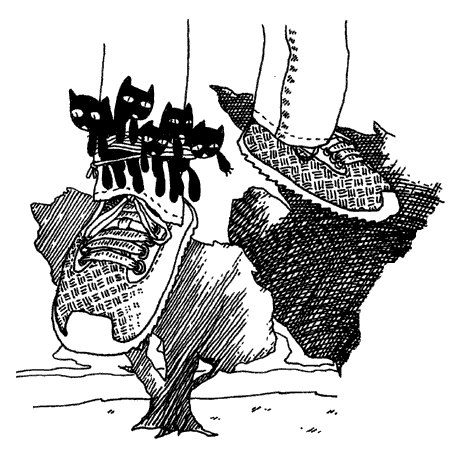This post was written by Rosie Cima, a Priceonomics contributor
![]()
From 2004 to 2009, one of the most prolific programmers on the Internet went simply by the moniker “Why the Lucky Stiff.” Or by his Twitter username “_why.”
Few knew who “_why” was in the real world, but his online persona was a force to be reckoned with. He built and authored dozens of free tools to help people learn to program, mostly in the Ruby programming language, which spread like wildfire, partly due to his influence. And he did it with a sense of humor.
His text book, which he posted for free online, was titled why’s (Poignant) Guide to Ruby. “Poignant” because he wanted to teach people to write code so beautiful it made them cry. To this end, the (Poignant) Guide’s narrator claims that the book, which most people read as an e-book, “comes with an onion”:
So you’re like, “Wow, this book comes with an onion!” (Even if you don’t particularly like onions, I’m sure you can appreciate the logistics of shipping any sort of produce discreetly inside of an alleged programming manual.) […]
I’ll be straight with you. I want you to cry. To weep. To whimper sweetly. This book is a poignant guide to Ruby. That means code so beautiful that tears are shed. […] You really must sob once. Or at least sniffle. And if not, then the onion will make it all happen for you.
He also made Try Ruby, a free, interactive website that walked an amateur programmer through the very first steps of learning, as well as a programming environment for children to learn to code, which he whimsically named Hackety Hack. His publications had funny illustrations in them of animals and rock stars. The (Poignant) Guide even came with an original indie-rock soundtrack, which included songs about bacon.
As Steve Klabnik, one of _why’s collaborators, has been quoted as saying: _why was not a “programmer,” he was “an artist whose medium was code.”
An air of mystery surrounded Why the Lucky Stiff, who became the closest thing the programming world had to Batman. His audience appreciated him enough that they respected his choice to conceal his offline identity. When invited to speak at conferences, he would register under a pseudonym, pay in cash, and jokingly wear sunglasses to half-heartedly conceal his appearance.
Then, one day, Why the Lucky Stiff disappeared completely.
A comic from why’s (Poignant) Guide to Ruby
Just before his disappearance, _why’s anonymity was compromised. An anonymous blogger had combed the early records of _why’s online communities, his patent records, and his associated IP addresses. The blogger presented, in incredible detail, proof that he had discovered _why’s real identity.
As it turned out, _why was some guy in Utah who worked for a consulting firm. On the Internet, he was a legend. In the real world, he was no Bruce Wayne—just another normal person.
With his name revealed, _why did something that shocked the programming community: he committed digital suicide. He scrubbed himself from the Internet. His open-source repository and all its code, his blog, his applications, his books, and his Twitter account—he deleted them all. It appeared that Why the Lucky Stiff, the beloved performance artist of the programming world, had given his last performance: a vanishing act.
This devastated the multitude of programmers who relied on his work. Some people were angry to be left in the lurch, but more just felt sad that his art was gone.
These fans immediately launched an effort to salvage the deleted material from the digital detritus. _why hadn’t made any effort to hand off his projects, which meant nobody was responsible for keeping his important projects like Hackety Hack and Try Ruby up-to-date. Why the Lucky Stiff also wasn’t great at leaving comments in his code, so inheriting one of his projects meant going through it, line by line, and figuring out what each function was for.
Over the past five years, many of _why’s projects have flourished in the hands of others. And many of these successors have noted that their success depended on their eventual willingness to delete the code _why authored. As Steve Klabnik, who inherited Hackety Hack, told a Slate reporter, “_why’s programming just really is not very good.”
“That doesn’t mean he wasn’t brilliant,” he added.
When most programmers call code beautiful, they mean that it executes its task efficiently and that it’s easy for other programmers to read, work with, and build upon. By this standard of beauty, much of _why’s code is very ugly.
But _why’s brilliance was that despite being so wildly creative that some people questioned his sanity, he channelled that creativity into code that people actually used. As Diogo Terror wrote in his article, “_Why: A Tale of a Post-Modern Genius,” it’s much better to articulate your ideas than to worry about articulating them perfectly: “He just creates things and gets them out there in the wild, unafraid whether people think it’s ‘crappy’ or ‘unprofessional.’”
In short, _why took risks. He once expressed, “If you worry too much about being clean and tidy, you can’t push the boundaries (I don’t think!)” Another time he suggested that: “When you don’t create things, you become defined by your tastes rather than ability. Your tastes only narrow and exclude people. So create.”
So _why published imperfect things, and many people found many of them useful. While some of his products weren’t particularly well-built, they were useful enough that others later spent time rebuilding them. Adults and children still learn how to program using his tools; he’s still quoted and revered; and his books still teach and entertain.
Most people who become as famous as _why try at some point to turn their fame into money. Instead, _why chose to remain anonymous. When that was no longer an option, he dissolved his Internet persona completely.
_why’s most recent project, or at least the project most recently attributed to him, is a brief novel.
It was published when his old blog at http://whytheluckystiff.net came back online for a few months displaying only one, cryptic line of code: “Public Print Queue SPOOL/DESOLEE 2012-01-06T08:21Z.”
Then, for one day in April, the website listed a series of printer commands which, if executed, printed out an 84-page document. The site went offline a day later, and the url now hosts a seemingly unrelated Australian’s personal blog.
In the text, the author of the novel claims to be _why. It’s a claim that many people accept. The author discusses his disappearance, pseudo-anonymity, and his relationship to programming as an art form. He expresses remorse. He says his intent in writing the novel is to open-source the character of _why as he once open-sourced his code. To put _why’s manifesto into the world, as flawed as it might be:
“I want to make it perfectly clear that these papers and all my other works in life belong to the general public. In fact, I also would like to turn myself over to all of you as well. This was actually done several years ago, but in an embarrassingly disorganized manner. I like what you’ve done with the character, but I’d like to step into his tattered suit for the next hundred pages and a day. And after that, I’m yours again. Do what you must do! I always enjoy seeing what happens to me.”
Our next post investigates the impact of online dating on “mixed-attractiveness” couples. To get notified when we post it → join our email list.
![]()
All comics in this article are from why’s (Poignant) Guide to Ruby
Note: If you’re a company that wants to work with Priceonomics to turn your data into great stories, learn more about the Priceonomics Data Studio.








